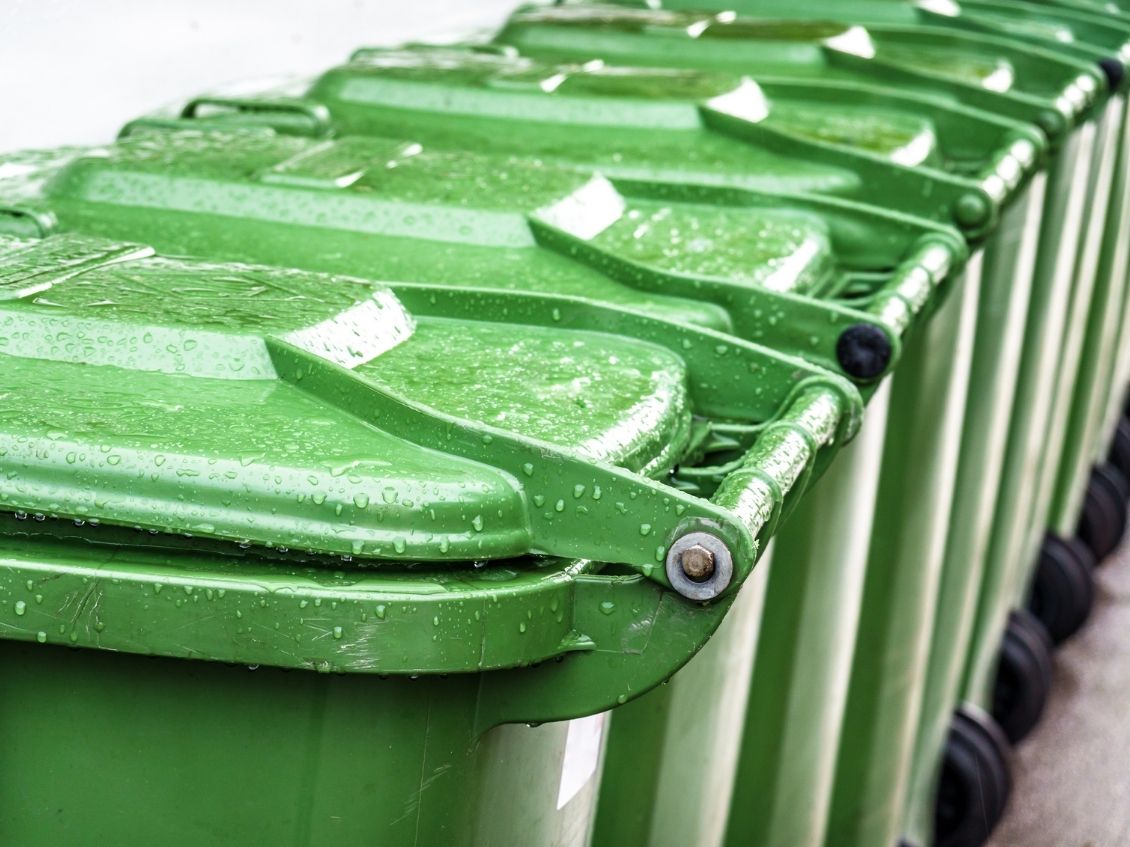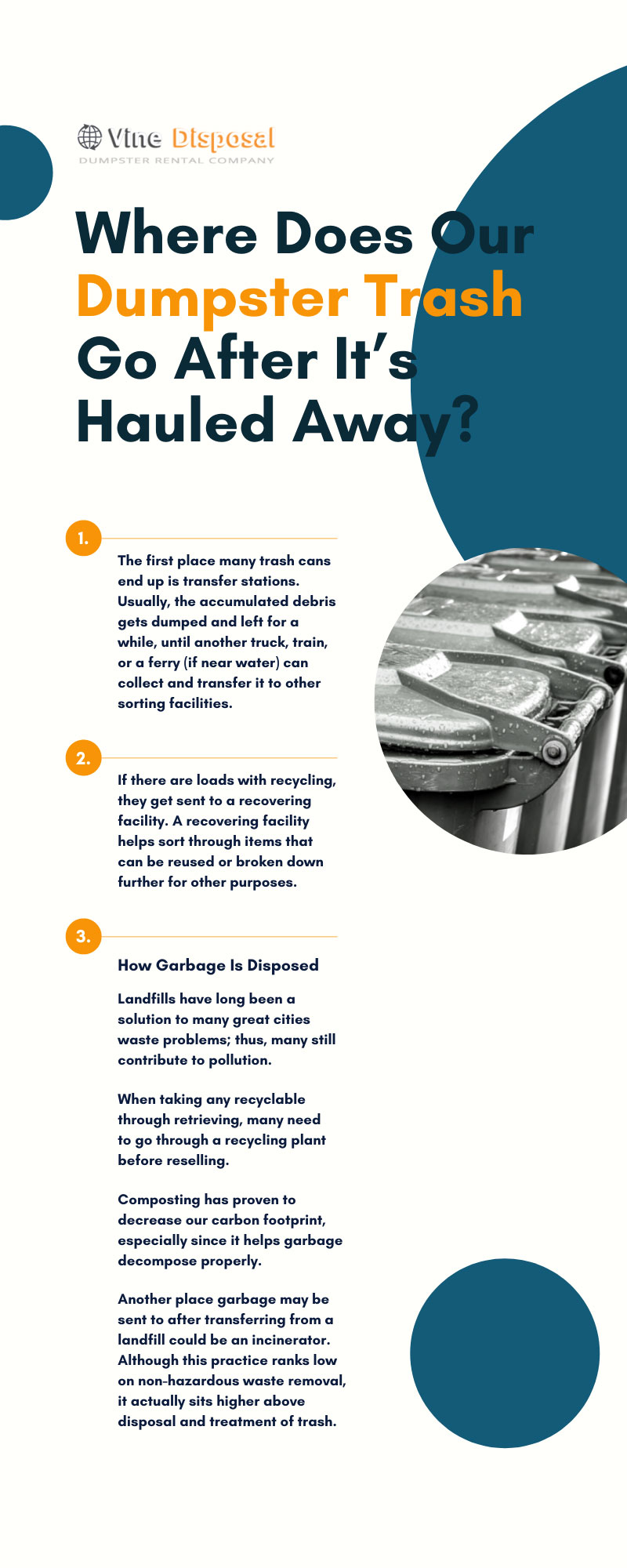
We may only think of Landfills when dumpster towing comes to mind. However, we don’t think that’s the only place dumpsters go when they’ve collected enough trash. So, let’s start off our day by finding where our dumpster trash goes after it’s hauled away.
After It Leaves Your House or Business
Once a vehicle takes a dumpster off the property, it’s no longer your problem. However, we often wonder where our dumpster goes after it’s hauled away. Aside from landfills, the dumpsters filled with waste first enter a transfer station or immediately head to a recovery facility if you have any recyclables.
So, let’s find out what happens to garbage when it enters a transfer station, followed up with the recovery facility.
A Transfer Station
The first place many trash cans end up is transfer stations. Usually, the accumulated debris gets dumped and left for a while, until another truck, train, or a ferry (if near water) can collect and transfer it to other sorting facilities.
Although garbage sits for a while, it gives garbage collectors more time to collect waste at once and then dump it in one spot before being moved to an endpoint.
A Material Recovery Facility
If there are loads with recycling, they get sent to a recovering facility. A recovering facility helps sort through items that can be reused or broken down further for other purposes. Furthermore, products like paper goods get picked and sold back to manufacturers.
In other words, the to-go styrofoam container you receive from your favorite restaurant was resold to a manufacturer and made into a new container again.
However, the one thing we often get concerned with is plastic. Plastic actually goes through its own process, just like glass.
When plastics are found, we don’t toss them since they can be reused. When both materials appear on the belt, plastics are immediately moved to another conveyor belt to be sorted and placed in a separate container.
Additionally, electronics that are found get picked up by giant magnets. This helps prevent objects from accidentally going to the wrong distributor when selling back.
Now that we know where garbage goes after the dumpster leaves our driveway and recycling’s sorted, let’s find out how it is disposed of.
How Garbage Is Disposed
Again, we may think it’s only landfills that collect garbage, but landfills work differently from other places like recycling plants, composting plants, waste-to-energy plants. We might think recycling and landfills are similar, but they’re entirely different spectrum entities.
Landfills
Even though our world’s riddled with landfills, it’s not the only place to house garbage and even recycling. Landfills have long been a solution to many great cities waste problems; thus, many still contribute to pollution.
However, many of our landfill workers do a new job of keeping waste at bay, especially with the way they layer garbage.
For example, when more trash enters, the employers place sheets of clay or plastic down to keep piles separated. Then, liquid waste material comes to the surface and coats the garbage. No worries, though; the liquid’s treated with special chemicals to make it safe to use.
Overall, landfills have done their part in keeping the cities clean, but they come with downfalls. Here is a list of benefits and drawbacks of landfills.
Benefits of Landfills
- Great source of energy
- Every practice is eco-friendly
- Contains the sanitization of cities
- Takes hazardous waste
- Saves money
- Excellent jobs for towns and cities
Drawbacks of Landfills
- Harms the environment
- Produces methane gas
- Harms soil and water
- This leads to the extinction of wildlife
- Harms humans
- Methane gas used as fuel
Recycling Plants
When taking any recyclable through retrieving, many need to go through a recycling plant before reselling.
For example, when we discussed how styrofoam resells after sorting, it also goes through a recycling plant to be broken down so manufacturers can use the material.
However, there’s more groundwork that needs covering, such as the type of plastic when it comes to plastic. When plastic products enter, they first get sorted and thoroughly cleaned of any contamination.
Afterward, the materials are sorted into pallets to ship to manufacturers to remake and sell to businesses to help keep communities eco-friendly and clean.
Composting Plants
Now that we’re back at landfills again, it’s time to find out what happens after these trains, boats, or other transportation machines pick up the trash.
The great thing about the transportation process is when a train arrives, the landfill’s messy array of garbage piles is made into garbage cubes.
In other words, garbage piles go through composting, which places garbage on a conveyor belt that brings it through a machine and forms garbage into blocks.
Composting has proven to decrease our carbon footprint, especially since it helps garbage decompose properly. The compost disintegrates properly in shaded areas, especially when there’s no wind.
Additionally, to avoid horrid smells, here’s what not to compost, and what you should compost.
Please Compost These
- Eggshells
- Vegetable scraps
- Leaves
- Weeds
- Fruit seeds
- Newspaper
Please Don’t Compost These
- Pesticides
- Feces
- Wildlife
- Invasive plants
- Ashes
Incinerators
Another place garbage may be sent to after transferring from a landfill could be an incinerator. Although this practice ranks low on non-hazardous waste removal, it actually sits higher above disposal and treatment of trash.
However, the way it works is that trash gets placed into an incinerator, and close to 10% breaks down, and the energy produced helps heat water that turns to steam. When steams are created, they can generate electricity.
All in all, the first place that starts this magnificent journey is your home’s driveway or the back of a commercial building. Either way, it’s vital to comply with all health and safety codes when ordering a roll-off dumpster in Marietta, GA from Vine Disposal.
At Vine Disposal, we know how the entire pick-up and drop-off process works, and we’re sure you have more questions you’d like answered.
So, while sifting through questions, get a budget in order and find out about our different dumpster sizes to help give an idea of what dumpster size rental works for you and your project or business.
We’re thrilled to offer many ways for customers to come together to learn more about what happens to their trash after it’s picked up. Vine Disposal provides many ways to learn more, so contact us here for more information on dumpster removal and rental.

